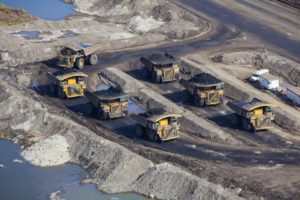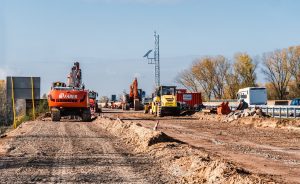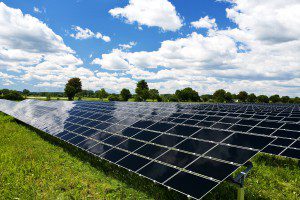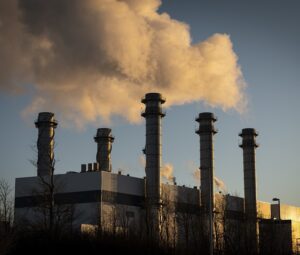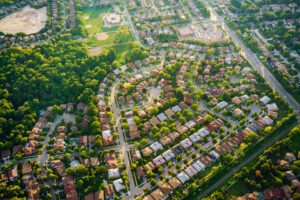CALGARY/TERRITORIES OF THE BLACKFOOT AND PEOPLES OF TREATIES 6 AND 7, HOME TO MÉTIS NATION OF ALBERTA, REGION III — A local First Nation and environmental groups are sounding the alarm after the Alberta government and Alberta Energy Regulator (AER) denied their request to order an environmental impact assessment (EIA) for a massive carbon capture project in Alberta’s oilsands.
The request for an EIA was made by Ecojustice on behalf of the Athabasca Chipewyan First Nation (ACFN) and several environmental and community organizations in May 2024, to ensure the $16.5-billion Pathways Alliance project will not have significant adverse impacts on the environment, local communities, and the rights of Indigenous peoples. This week, the AER responded that it would not be ordering the assessment.
The Pathways Alliance — a consortium of Canada’s six largest oilsands producers accounting for 95% of the country’s oilsands production — plans to develop a carbon capture and storage (CCS) project that would capture carbon dioxide from at least 13 oilsands facilities in northeastern Alberta and transport the carbon via over 600-km of pipeline to an area south of Cold Lake, AB, where it would be injected underground for storage. This is the largest CCS project ever proposed in Canada, and one of the largest globally.
Over recent months, the Pathways Alliance has been applying to the AER for various authorizations that are necessary to build the project. Pathways has split the megaproject into at least 66 smaller segments and has made multiple applications for each — at least 126 by the time they are all submitted.
An EIA is an opportunity to look at a project as a whole and ensure all environmental, economic, health, and social impacts of the project are adequately identified and addressed. This is why it is a standard step across Canada when assessing projects of this size. By failing to conduct an EIA, the AER is allowing a piecemeal approach, known as “project splitting,” which impairs the AER’s ability to adequately identify and assess all project-specific, direct, indirect, and cumulative impacts.
The lack of an EIA also undermines Indigenous and other frontline communities’ ability to understand the impacts of this project on their rights. Assessing impacts on Aboriginal and Treaty rights is required as part of Alberta’s duty to consult, but ACFN has been seeking critical information about this project from both Alberta and the Pathways Alliance for over two years — to no avail.
Concerns about the environmental and health impacts of CCS projects are well documented around the world. These projects can exacerbate air pollution, put stress on watersheds, risk groundwater contamination, and cause dangerous leaks and explosions. Since 2010, there have been 76 incidents involving carbon dioxide pipelines in the US. For example, a carbon dioxide pipeline exploded in Satartia, Mississippi in 2020 and a carbon dioxide pipeline leaked in Louisiana in April 2024. In October 2024, citing a carbon dioxide leak at a CCS project in Illinois, more than 150 environmental and advocacy groups asked the US Environmental Protection Agency to halt carbon dioxide injections and stop permitting new wells until regulations are revised. Following an environmental assessment, in May 2024, the government of Queensland, Australia rejected a proposed CCS project in the Great Artesian Basin due to concerns that carbon dioxide injected underground would cause groundwater contamination. The Government of Queensland has now banned carbon storage in Australia’s largest groundwater basin.
Questions have also been raised about who is paying for this multi-billion dollar project. Despite record production and profits in the oilsands in recent years, the Pathways Alliance does not want to pay for the CCS project itself. Instead, the oilsands consortium expects Canadian taxpayers to pay — calling upon provincial and federal governments to provide financial support. The federal government has developed investment tax credits to incentivize CCS projects, which would cover half of the capital costs, while Alberta would cover an additional 12%. Pathways is also currently negotiating “contracts for difference” with the federal government, which would guarantee the Pathways Alliance ongoing profits at an established carbon price. This all could mean that the public bears most of the costs, and private companies get all of the potential benefits.
With Alberta unwilling to assess the risks this project poses to the environment and local communities, it is an open question whether the federal government will step in to assess the risks of this megaproject.
Representatives from the groups said the following:
Chief Allan Adam, Athabasca Chipewyan First Nation:
“There’s a reason the AER doesn’t want to put the Pathways project through an environmental assessment. It is because it will expose the environmental impacts, the poor economic viability and the risks to human health. We know the AER works with industry to cover up their messes, this is just another example, a big example. With our Treaty rights on the line you can guarantee that ACFN will fight this tooth and nail.”
Matt Hulse, lawyer at Ecojustice:
“Just as the Competition Act was being strengthened this past year to introduce stronger anti-greenwashing provisions, the Pathways Alliance’s website was scrubbed. An environmental assessment is an excellent way to test whether the Pathways claims are actually true – not just about its ability to reduce emissions and help address climate change, but to do so safely and cost-effectively, particularly given all the taxpayer money they want to spend. With Alberta unwilling to assess this project, we hope that the federal government will step up.”
Phillip Meintzer, conservation specialist at Alberta Wilderness Association:
“The AER’s decision shows that Alberta’s environmental impact assessment process is fundamentally flawed. Project-splitting is a loophole that allows large industrial projects to steamroll ahead while ignoring cumulative impacts – putting Albertans, Indigenous communities, and ecosystems at risk of harm. It’s like saying that drivers don’t need a license to operate a vehicle because the individual parts aren’t technically a whole car. It’s absurd.”
Julia Levin, Associate Director, National Climate, Environmental Defence:
“Alberta’s decision to skip an environmental assessment of the Pathways Alliance’s massive carbon capture project is further evidence that the government has no desire to protect the health and safety of its residents. Carbon capture infrastructure is enormously risky, and Alberta lacks any robust safety oversight. Pipeline ruptures and carbon dioxide leaks can be devastating and put Alberta’s drinking water at risk. The communities that would bear all of the risks from the project deserve to have real answers about the dangers posed to their families.”
Emily Lowan, Fossil Fuel Supply Lead, Climate Action Network Canada:
“This decision is a slap in the face to all the communities who will have to bear the costs and consequences of this risky project. This year alone, we’ve seen regions like Queensland Australia and Illinois pump the brakes on carbon capture projects for health and safety reasons. Local residents don’t want to live in a hazardous waste disposal site, putting their drinkable water and air quality at risk. To subject renewable energy projects to suffocating restrictions, yet skip a comprehensive health and environmental assessment for a massive project from the fossil fuel industry, makes the Alberta government’s double standard abundantly clear. ”
Background
- On May 13, 2024, Ecojustice submitted a request on behalf of the Athabasca Chipewyan First Nation, Alberta Wilderness Association, Climate Action Network, Environmental Defence, and the No to CO2 Landowner’s Group to the Government of Alberta and the Alberta Energy Regulator (AER) to conduct an environmental impact assessment of the Pathways Alliance’s carbon capture project.
- CCS is massively expensive, with a terrible track record. Analysis from IEEFA concludes that most projects fail, and the few that are able to get off the ground underperform. A 2023 report out of Oxford University found that heavy dependence on CCS to reach net zero would cost at least $30 trillion USD more than a route based primarily on renewable energy, energy efficiency and electrification. Internal documents released by the US House of Representatives Oversight Committee reveal that oil and gas companies see CCS as a way to get social license to continue producing fossil fuels for decades to come.
- Project Risks: A CCS project of this magnitude introduces a suite of potentially dangerous consequences. The capture, transportation, and storage of carbon dioxide have significant environmental impacts and raise a host of health and safety concerns, including:
- Leakage: carbon dioxide is an asphyxiant and, when leaked, can cause dangerous health effects including disorientation, confusion, rapid loss of consciousness, even death. Carbon dioxide is colourless and odourless, making it extremely difficult to detect and avoid leaks from pipelines or storage sites, putting nearby communities at risk.
- Emergency management: Alberta does not mandate an emergency response plan for carbon dioxide pipelines and does not mandate the release of information about how carbon dioxide is likely to disperse. These CO2 plumes can spread significant distances from the point of release.
- Groundwater contamination: an increase in carbon dioxide in underground aquifers can cause lead, arsenic, and other heavy metals that are contained in rocks to leach into water sources, putting drinking water quality at risk.
- Risk of explosion: when carbon dioxide is compressed for transport in a pipeline, it becomes highly volatile, creating risks of extremely dangerous pipeline explosions.
- Water consumption: the equipment used to capture carbon generates heat and must be cooled with water, which would be drawn from the Athabasca River system – putting more pressure on a watershed already under stress.
- Pollution: carbon capture equipment burns natural gas, increasing regional air and water pollution. The project also runs risks of underground leakage back into the atmosphere, groundwater contamination from stored carbon dioxide.
About
The Athabasca Chipewyan First Nation are K’ai Tailé Dené, the “people of the land of the willow.” This name signifies ACFN’s deep connection to their traditional territories, which are centred on the Peace-Athabasca Delta in what is now known as northeast Alberta. ACFN signed Treaty 8 in Fort Chipewyan in 1899 and continues to exercise their Treaty rights and maintain their cultural identity.
Alberta Wilderness Association is the oldest Alberta-based environmental conservation group with more than 7,500 members and supporters in Alberta and around the world. AWA seeks the completion of a protected areas network and good stewardship of Alberta’s public lands, waters, and biodiversity to ensure future generations enjoy the abundant benefits they provide.
Climate Action Network – Réseau action climat Canada (“CAN-Rac”) is a network of organizations taking action on climate and energy issues in the land currently called Canada.
Ecojustice uses the power of the law to defend nature, combat climate change and fight for a healthy environment. Its strategic, public interest lawsuits and advocacy lead to precedent-setting court decisions, law and policy that deliver lasting solutions to Canada’s most urgent environmental problems. As Canada’s largest environmental law charity, Ecojustice operates offices in Vancouver, Calgary, Toronto, Ottawa and Halifax.
Environmental Defence is a leading Canadian environmental advocacy organization that works with government, industry and individuals to defend clean water, a safe climate and healthy communities.
No to CO2 Landowners Group is a grassroots, nonpartisan organization of friends and neighbors in the County of St. Paul and Municipal District of Bonnyville, Alberta. It is concerned with protecting their land and preserving their quality of life.
– 30 –
For more information or to request an interview, please contact:
Jay Telegdi | Athabasca Chipewyan First Nation
Jay.telegdi@acfn.com
Cari Siebrits, Communications Strategist | Ecojustice
csiebrits@ecojustice.ca
Phillip Meintzer, Conservation Specialist | Alberta Wilderness Association pmeintzer@abwild.ca
Midhat Moini, Communication Manager| Environmental Defence
mmoini@environmentaldefence.ca
Vicky Coo, Communications Manager | Climate Action Network Canada
comms@climateactionnetwork.ca
The post Alarm bells raised as Alberta’s refusal to assess dangers of massive oil sands carbon capture project sparks safety concerns appeared first on Environmental Defence.
This post was originally published on Environmental Defence.




